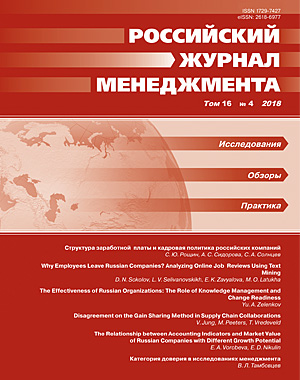Категория доверия в исследованиях менеджмента
DOI:
https://doi.org/10.21638/spbu18.2018.406Аннотация
Анализ влияния доверия на различные стороны функционирования и взаимодействия фирм занимает значимое место в исследованиях менеджмента. Вместе с тем само понимание феномена доверия далеко от четкости и однозначности — это понятие пока не имеет ясного и общепринятого определения. На базе анализа широкого множества пониманий доверия в статье предлагается понимание доверия как ментальной репрезентации ожидания неоппортунистического поведения контрагента, возникающей неосознанно, но сознательно корректируемой на основе поступающей новой информации. Основу этой репрезентации можно назвать личным концептом доверия индивида. Личный концепт доверия представляет собой совокупность нейронных процессов и состояний (нейрокоррелятов), сформировавшихся и изменяющихся в течение всей жизни индивида, которая выступает для него основой оценки потенциальных доверяемых. Показано, что имеющиеся трактовки доверия логически выводятся из предложенного в статье его понимания. Рассматриваются некоторые прикладные следствия предложенного понимания доверия.
Ключевые слова:
доверие, исходное доверие, нейрокоррелят, личный концепт доверия
Скачивания
Библиографические ссылки
REFERENCES
Загрузки
Опубликован
Как цитировать
Выпуск
Раздел
Лицензия
Статьи журнала «Российский журнал менеджмента» находятся в открытом доступе и распространяются в соответствии с условиями Лицензионного Договора с Санкт-Петербургским государственным университетом, который бесплатно предоставляет авторам неограниченное распространение и самостоятельное архивирование.





